
Belfast Telegraph, 6 September 1917
With thanks to the British Newspaper Archive (www.britishnewspaperarchive.co.uk)
Diana Scott’s involvement in women’s football was part of a wider surge in interest in the women’s game across Britain during the First World War. In England, isolated games were played in 1915 and 1916, but it was from 1917 onwards that it began to spread, including to Ireland. The earliest games seem to have taken place in Belfast in September 1917, before quickly spreading to nearby Lurgan and Portadown. As in England, one stimulus was the use of these games to raise money for wartime charities. Another similarity was the apparent popularity of the game amongst working-class women, particularly those working in factories, with several teams connected to the weaving industry in Portadown in County Armagh.[1]
From the start Diana seems to have been prominent in organising charity games, something she was well placed to do. She had already shown that she had administrative drive and organisation in her charity work. And as the wife of a club secretary of a major club with a large ground, she was well placed to both understand and organise the arrangements required for major spectator events. From what we know of the development of women’s football in the First World War, Diana seems to have been the only spouse of a club official to take a leading role in the organisation of women’s games, something that tended to be the preserve of male officials.
In September 1917 she organised three well attended games, all held at Distillery, bringing in around £534. The first on the 7 September was between the Whites (Distillery) and the Stripes (Belfast Celtic) and proved such a success, with an estimated crowd of 16,000, that it was replayed on the 14 September, again before another large crowd. On the 26 September, an estimated 5,000 spectators watched Belfast Ladies take on a men’s side from the Royal Navy. The men had their legs tied, a variation on a variety of different handicaps given to male players in games of this nature during the war.[2] In October ‘The Famous Belfast Ladies Team’ journeyed to play Messrs’ Rob’s Red Cross Team in Portadown. It was held as part of a fete and many journeyed in to see the area’s very first women’s game. This seems to have stimulated the women’s game in the Portadown area, with further games held in 1917.[3]
Diana’s importance seems to have been recognised from the start. The Unionist Belfast News-Letter gave detailed coverage to the post-match reception afforded to the players and officials involved in the first game, held in support of the Belfast Service Club.[4] Under the title, ‘Lady Footballers’ Handsome Contribution’ the paper described how Lady Liddell, ‘gracefully presented to each of the ladies who took part in the match – and also to Mrs. Scott, who was primarily responsible for the organisation of the fixture – handsome mementoes of the occasion in the shape of a silver satchel.’ Walter read out the statement of the accounts before Diana, ‘amid loud applause, formally handed to the chairman a cheque for £239, 9s 6d.’[5] Sir Robert Liddell, the Chairman of the Belfast Service Club, then offered his praise.

Belfast News-Letter, 21 September 1917
With thanks to the British Newspaper Archive (www.britishnewspaperarchive.co.uk) and JPI Media
What makes this dinner even more notable, was the presence of leading Irish football officials. Among those applauding was John Ferguson (Secretary, Irish Football Association), D.W. Foy (Hon Treasurer, IFA) and Thomas Toppington (Chairman, Irish Football League). Their presence indicates that, at least during wartime football, that they were happy to be associated with and endorse women’s games.
However, the most notable triumph of Diana’s football career was still to come. Women’s football in North East England proved particularly popular in 1917. One of the male players who supported its development was Newcastle United’s Irish international defender William McCracken. In addition to refereeing several games, he helped arrange the visit of an England team, selected from north-eastern players, for a Boxing day game in Belfast. It attracted a large crowd, estimated at between 12,000 to 20,000 spectators.[6] The Mayor of Belfast kicked off while McCracken was the referee, with Newcastle teammate and Scottish international, James Lawrence, and Manchester United’s Irish international Mick Hamill running the lines. England won 4-1 and the match raised £459. While Diana was not mentioned by name in the organisation of the game, the Ladies Guild was noted as being the organisers, while she was responsible for distributing the money.[7] Donations were made to the Ballykinlar Camp Building Fund, the comforts funds of the 3rd Battalion Royal Irish Rifles, and to provide two hospital beds, which were to be named, ‘Lady Footballers, In Memory of the Fallen Members of Distillery Football Club.’[8]

A record of how some of the proceeds from the Boxing Day International of 1917 were distributed.
Belfast News-Letter, 24 May 1918
With thanks to the British Newspaper Archive (www.britishnewspaperarchive.co.uk) and JPI Media
Diana continued her efforts throughout 1918, garnering further praise. In January spectators were treated to a game between female members of the “Boy Blue Pantomine” v The Belfast Whites, organised with Mr James McCann, manager of the Royal Opera House.[9] Attracting a ‘capital attendance’ the game raised over £105. In June they beat ‘Mrs Mercer’s’ team in a five-a-side game, part of a Sports Carnival held to raise funds for local war charities.[10] September was a busy month, with the team travelling to Newcastle with one paper explaining that ‘Mrs Walter Scott, the good lady of the Distillery secretary was responsible for the idea.’[11] They were to play a game as part of the Lord Mayor’s Relief Fund. The game was held at St. James’ Park, but bad weather and the Spanish flu pandemic meant a disappointing crowd of 2,000. Diana accompanied the team as their manager. In the absence of the Lord Mayor, she was given the honour of kicking off the game which ended in a 5-2 win for England.[12] A week later the Belfast Whites played Messrs Ewart’s factory as part of a fete for the Ulster Women’s Gift Fund, beating them 2-1. Between 2-3,000 people attended the event at the Botanic Gardens.[13]
The Armistice did not signal an end to Diana’s charitable activities. In December 1918 she organised a game between Lady Internationals and a men’s Military XI, held at her husband’s new club, Glentoran.[14] At this time the Northern Whig recorded that she had been asked and, ‘with her usual courtesy has kindly consented,’ to organising a ballot in connection with a game for the Belfast Soldiers’ and Sailors’ Service Club. The winner was to receive a silver-mounted flower vase and the paper felt that, ‘the affair could not be in more capable hands. Look out for Mrs. Scott and her band of willing workers at forthcoming matches.’[15] In April 1919 she organised a game for the same fund, played between the Belfast Whites (Strengthened) and Ewart’s Ladies. Her team was strengthened by Mary Lyon, who had scored a hat-trick when England had beaten Ireland 5-2 in Newcastle in 1918.[16] Again, Diana was thanked by the Belfast Branch of the Comrades of the Great War for organising a match that had raised £160.[17] She was also to the fore in August 1919, organising a game between Belfast Whites and a team of former male stars called “Old Crocks.” This was to help the widow of orphans of Corporal Vance who had died in an accident while awaiting demobilization after four years’ service in the army.[18]
Things seem to have been quieter in 1920. There were plans for a visit by a French team and a trial match was held on the 15 May. The Whites beat the Stripes 6-1 before a ‘splendid attendance’ that raised over £200 for the Hospitals Gala fund.[19] However, the visit of the French side fell through though due to the size of the financial guarantee that they required (£600).[20]
In January 1921, it was decided to recognise all of Diana’s efforts with a testimonial game. This was a significant gesture, previously only afforded to leading male officials and players. A Committee was set-up, aptly holding its first meeting at the Belfast Comrades Club. In the chair was Mr. Herbert Dixon, who became a Unionist MP for the Northern Irish Parliament later in the year. He presided over a ‘large and receptive audience’ where Linfield FC offered the use of Windsor Park for free.[21] At that stage it was hoped that ‘Dick Kerr’s famous Ladies Club could come to Belfast’ but it seems appropriate that in the end it was a team from the northeast of England that played, given Diana’s wartime links to the region. The Northern Whig provided coverage of the English side’s arrival, talking very positively about several of the players. Seven of the side had played for the North Eastern Ladies when they had drawn with Dick, Kerr Ladies FC. One of them was Minnie Seed, ‘the fastest lady footballer in England. She is a real dandy player, and is a sister of Seed, who plays for the FA Cup finalists, Tottenham Hotspur.’[22] Also picked out was Mary Lyons, who:
Has been aptly described as a “box of tricks.” Those who had the pleasure of seeing her for Mrs. Scott’s team against Ewart’s at Grosvenor Park will not quarrel with the descriptions given here. Altogether it is a grand team, and should be well worth seeing.
The praise for Mary Lyons was not misplaced, for she scored two, including the winner, in a 3-2 win for England. After the game, the teams were entertained at the Ye Olde Castle Restaurant.[23] Alderman Barron referred to the great work accomplished by Diana during the war ‘and her efforts on behalf of charity generally.’[24]
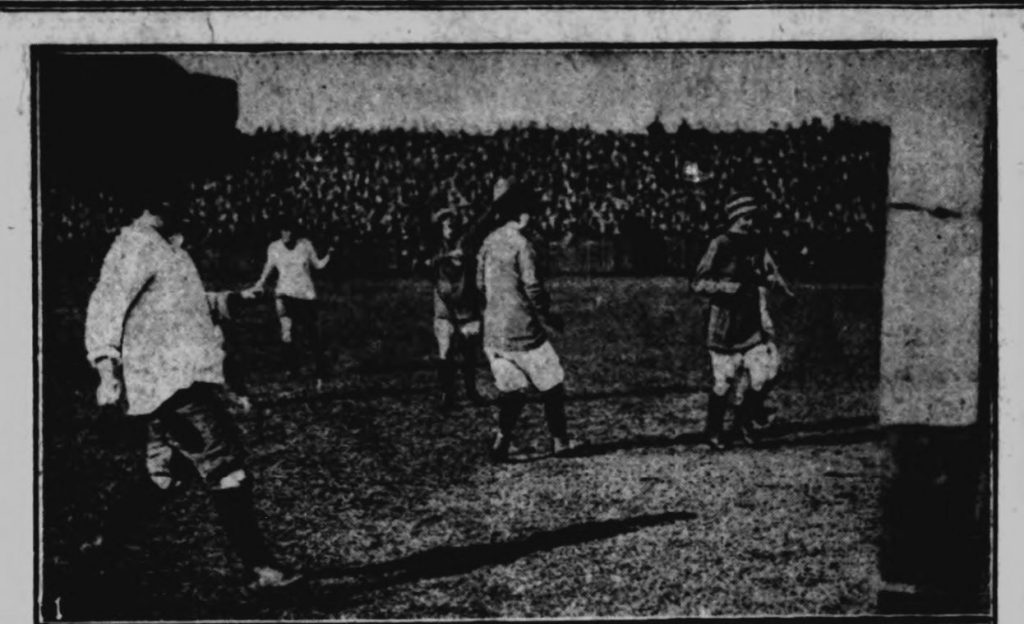
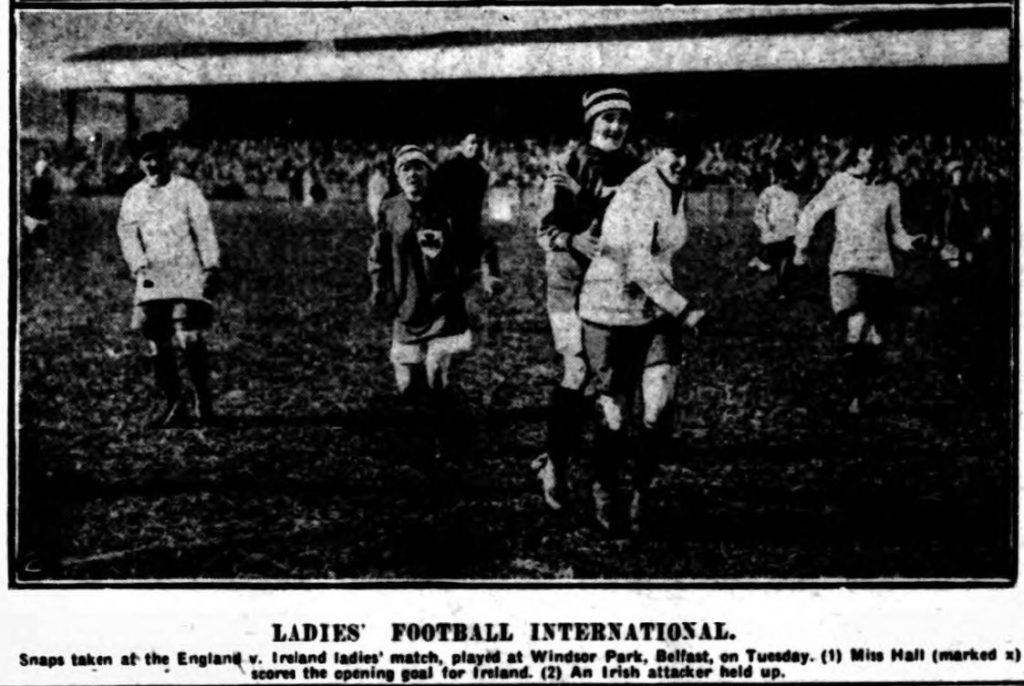
Belfast Telegraph, 31 March 1921
With thanks to the British Newspaper Archive (www.britishnewspaperarchive.co.uk)

Palmer’s Munitionettes, winners of the 1919 Munitionette Cup
Mary Lyons, described as a “box of tricks”, sits centre of the front row. She played in Belfast in 1919 and 1921
Courtesy of the Imperial War Museum. Q110074
This game was not the end of Diana’s efforts. Instead, it was the first of four games in 1921 that saw English teams visit Belfast, making it a key site in the history of women’s international football. During the summer she organised two visits by Fleetwood Ladies FC to play an Ireland international team in support of civilian and ex-servicemen charities. In May, the teams drew 1-1 at Glentoran’s Oval Ground. In June Ireland obtained what some newspapers called their first international win, beating Fleetwood 3-1 at Cliftonville’s Solitude’s ground. At the post match dinner, Mr S. Donald Chayse MP congratulated both teams and ‘Mrs Scott, who was the pioneer of ladies football in Ireland, on the success of their undertaking.’[25]
In October she finally arranged the visit of the famous Dick, Kerr Ladies. Belfast papers keenly anticipated the visit of the Preston team. One writer for the Northern Whig, who had seen them play at Blackpool, encouraged people to come and watch, ‘Miss Parr – who is one of the most finished footballers I have ever seen.’[26] The Belfast Telegraph enthused that, ‘everybody is anticipating with genuine pleasure the visit of the famous Dick Kerr’s team.’ It praised the ‘untiring Mrs Scott’ for organising the game and hoped that, ‘the Belfast crowd will give the reception they deserve, and pay them the compliment of turning up in such a big muster as will show their hearts are in the business.’[27] The paper also described the, ‘Elaborate arrangements [which] have been made to entertain the visiting combination, the programme including visits to the shipyards, to Gallacher’s factory, to the Hippodrome, and a motor drive round the Down coast on Tuesday afternoon.’

Northern Whig, 17 October 1921
With thanks to the British Newspaper Archive (www.britishnewspaperarchive.co.uk)
The Belfast side that met Dick, Kerr Ladies was specially reinforced with four English players. In its own way, this was a fitting tribute to the connections that Diana had developed with English football since 1917. From Fleetwood in Lancashire came goalkeeper Florrie Rance and forward Maggie Shaw, while from the northeast came Taylor of Newcastle-Upon-Tyne and Mary Lyons of Jarrow. Dick, Kerr Ladies proved the superior team though and ran out 6-1 winners. Retiring to the Ye Olde Castle Restaurant for the post-match dinner, the Chairman of the Hospital Sports Gale Committee thanked both teams for their efforts and acknowledged that they were ‘greatly indebted to Mr and Mrs. Scott.’ Alfred Frankland, the Dick, Kerr manager, also thanked them both, since they, ‘had gone to great trouble to make the members of the team at home. They hoped that there would be a silver lining to the dark cloud at present hanging over Ireland. (Applause)’[28]
Within a few months the English FA introduced a ban upon its clubs hosting women’s games. Despite this official discouragement in England, in Ireland the ban does not seem to have been immediately replicated. Mentions of games seem to be sparse though. In 1922 Diana agreed to arrange a game for the North Belfast Orange Memorial Hall Building Fund. This was to honour all Orange Order members who had died during the war. At a public meeting to discuss the project, the committee chairman paid tribute to the growing importance of women in the Orange Order’s work.
During the year several lodges had appointed lady members on the executive, and he had admired their unflagging energy, which had facilitated the work of the committee, who had realised that much of their success was due to the ladies.[29]
Interestingly, the IFA had refused permission for several men’s clubs to hold fundraising games.
Thanks to the historian Steve Bolton, we have one final sighting of Diana in connection with a women’s game. In 1925 the French team Femina Sport Club played a series of games against Dick, Kerr Ladies in England, Scotland, and Northern Ireland. The tour was in aid of the Shipwrecked Mariners Society and originally the gate receipts from the Belfast game were intended solely for this charity. Instead, Diana and Walter arranged for half of the receipts to go to local charities.[30]
On the 23 May the teams arrived and were welcomed by The Lord Mayor and ‘Mrs Walter Scott, who made the arrangements in connection with the visit.’[31] Several newspapers printed photographs of this meeting. These are the closest I have come to an image of Diana in my research so far.
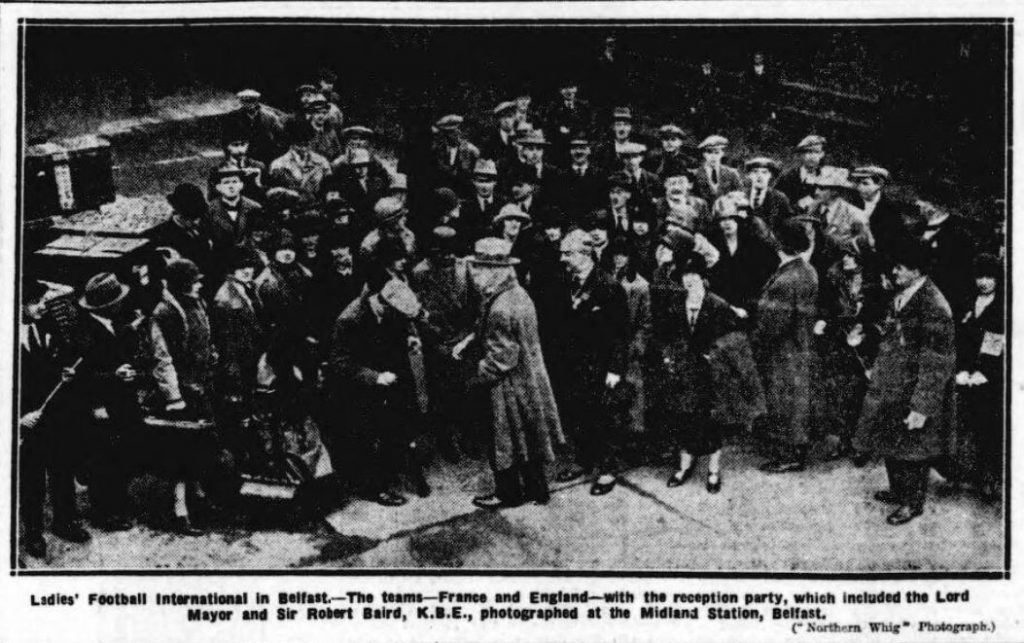
Somewhere in this photo is Diana Scott.
Northern Whig, 23 May 1925
With thanks to the British Newspaper Archive (www.britishnewspaperarchive.co.uk)
The game was held at Windsor Park, showing how the Irish FA had not followed the lead of the English FA in banning women’s teams from affiliated club grounds. Dick, Kerr Ladies won 4-2 and the game raised £450 for charity. As in earlier games the post-match dinner was held at the Ye Olde Castle Restaurant and Diana was seated at the top table alongside the Lord Mayor, the team captains, and other officials. The Belfast News-Letter recorded that:
Major C. Kent paid a tribute to Mr. and Mrs. Scott for their efforts in connection with the match. Mrs. Scott appeared to be able to draw everyone in to help her in a good cause, and as the outcome of this, expenses were considerably reduced.[32]
At the close of the dinner, ‘the toast of the health of Mr. and Mrs. Scott was honoured, after which the party engaged in dancing.’[33]
In June 1927 newspapers reported that Walter was resigning his post at Glentoran and taking on a new job as the manager of Frank Barbour’s racing stables. Reflecting on the couple’s achievements, the Northern Whig wrote that, ‘Mrs Scott will also be much missed in the city, as she accomplished more for the cause of sweet charity than ever found its way into print.’[34]
With these two articles, I hope that I have created some interest in this important figure in the early history of the women’s game. What has been presented is an initial, partial history of her life. There is so much more to find out and I hope that others will be encouraged to dig deeper into her story.[35]
Article © of Alex Jackson
Acknowledgments
I would like to thank Steve Bolton, Dr. Daryl Leesworthy, Dr. David Thoms and Nick Jones for their assistance in the research and writing of this article.
References
[1] Portadown News, 20 and 27 October 1917.
[2] Belfast Telegraph, 6, 13, 25, 27 and 29 September 1917, Sport (Dublin) 27 September 1917, Freeman’s Journal, 8 September 1917. Belfast News-Letter, 21 September 1917.
[3] Portadown News, 29 September, 13 October, 15 and 27 December 1917.
[4] Freeman’s Journal, 8 September 1918.
[5] Belfast News-Letter, 7 September 1917.
[6] The Northern Echo gives 20,000 while the Northern Whig gives 12,000 and the £450 gate, 27 December 1917.
[7] Belfast News-Letter, 25 December 1917.
[8] Northern Whig, 1 March and 22 April 1918. Belfast News Letter, 24 May 1918. Having named beds imitated the pre-war practise of men’s football clubs having beds named after them following donations.
[9] Belfast News-Letter, 28 January and 9 February 1918, Belfast Telegraph, 24 January and 31 January 1918,
[10] Belfast News-Letter, 17 June, 25 May, 30 September 1918.
[11] Sport (Dublin), 9 February 1918.
[12] http://donmouth.co.uk/womens_football/womens_internationals.html
[13] Belfast News-Letter, 30 September 1918.
[14] Northern Whig, 21, 23 and 25 December 1918.
[15] Northern Whig, 16 December 1918.
[16] Northern Whig, 19 April 1918.
[17] North Down and County Down Independent, 24 May 1919.
[18] Belfast News-Letter, 12 August 1919.
[19] Belfast News-Letter, 14 and 15 May 1920.
[20] Belfast News-Letter, 14 May and 28 July 1920. Belfast Telegraph, 7 August 1920.
[21] Northern Whig, 6 January 1921.
[22] Northern Whig, 28 March 1921.
[23] The restaurant was the site of several post-match dinners during the war. One wonders whether there is any mention in the business’ Directors Minutes, held at the Public Record Office of Northern Ireland. https://discovery.nationalarchives.gov.uk/details/c/F167445
[24] Northern Whig, 30 March 1921.
[25] Belfast Telegraph, 6 June 1921.
[26] Northern Whig, 17 October 1921.
[27] Belfast Telegraph, 24 October 1921.
[28] Northern Whig, 27 October 1921.
[29] Northern Whig, 22 June 1922.
[30] Belfast News-Letter, 25 May 1925.
[31] Northern Whig, 23 May 1925.
[32] Belfast News-Letter, 25 May 1925.
[33] Belfast News-Letter, 25 May 1925.
[34] Northern Whig, 26 June 1927.
[35] It is important to also explore her husband’s life story and his role in charitable activities. This would provide a fuller understanding of their relationship. For the purposes of this article, I have focused on Diana.

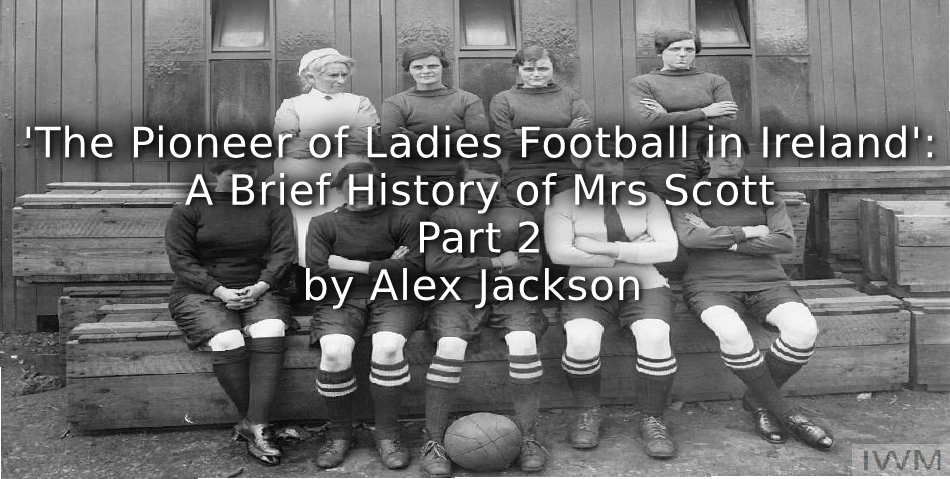


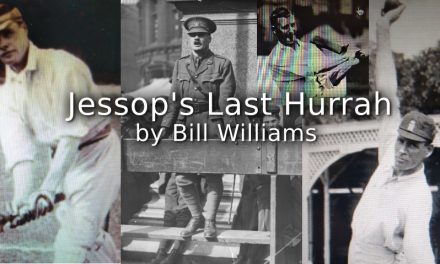

Hi
A very interesting article.
During your research have you come across any links to hockey? I have done some research in relation to early hockey leagues in England and many players played other sports, football, cricket and tennis are some examples. League hockey clubs were often linked to works teams and as football was not played every weekend I think many of the women footballers kept fit by playing league hockey which was played on many weekends during the winter.
We know there were hockey leagues in Ireland around this time and I wonder if the same connection with football and hockey can be found in Ireland.
Regards
Mark Evans
Volunteer with the Hockey Museum